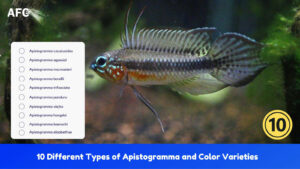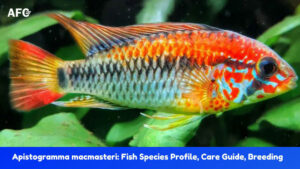A fairly new addition to the aquarium hobby, the Apistogramma ortegai is a mighty and aggressive member of the Apistogramma family.
Despite its undemanding of water conditions or habitat essentials, this species isn’t a good choice for beginner Apisto enthusiasts.
Before you make the leap, let’s take a closer look at its origins, characteristics, and necessary care requirements, like potential tank mates, tank setup, diet, and breeding.
Distribution & Names
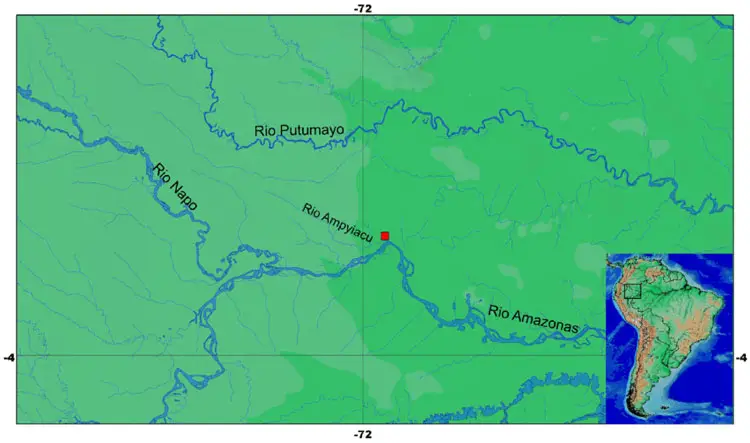
The Apistogramma ortegai was scientifically described in 2014 and is exclusively found in small streams and tributaries of the Ampiyacu River near Pebas in eastern Peru.
In the aquarium trade, this species can be found sold under many different names, including Apistogramma sp. “Algodon”, Apistogramma sp. “Algunas”, Apistogramma sp. “Papagei,” or Apistogramma sp. “Galaxis,” etc.
Unfortunately, some of these names are incorrect, and some can be confusing.
For instance, it’s often mislabeled as Apistogramma sp. “Putumayo,” a close relative from the same habitat (we will discuss the differences later).

In addition, there is a lot of confusion surrounding another trading name, Apistogramma cf. “Pebas,” in the Apistogramma community. Some experts believe they are totally different species due to the distinctive differences in their caudal spots and other subtle differences. [1]
Ricardo Britzke, who formally described A. ortegai, considered these differences to be insufficient enough to classify these two forms as separate species. Furthermore, given the fact that they can be found in the same collection sites, it’s hard to determine whether Apistogramma sp. ‘Pebas’ and Apistogramma sp. “Papagei” are indeed two different species or not until more genetic studies are conducted.
So, if you are planning to purchase this A. ortegai, be sure to ask the dealer exactly which form they have in stock. As with all wild-caught Apistos, females may not spawn with their closely related species.
How to Identify an Apistogramma ortegai?

Did you know that there are 25 recognized Apistogramma species in Peru, not to mention the undescribed ones and their geographic forms? That’s why identification isn’t always easy.
In order to properly identify your fish species, understanding the Apistogramma species-groups can be helpful. [2]
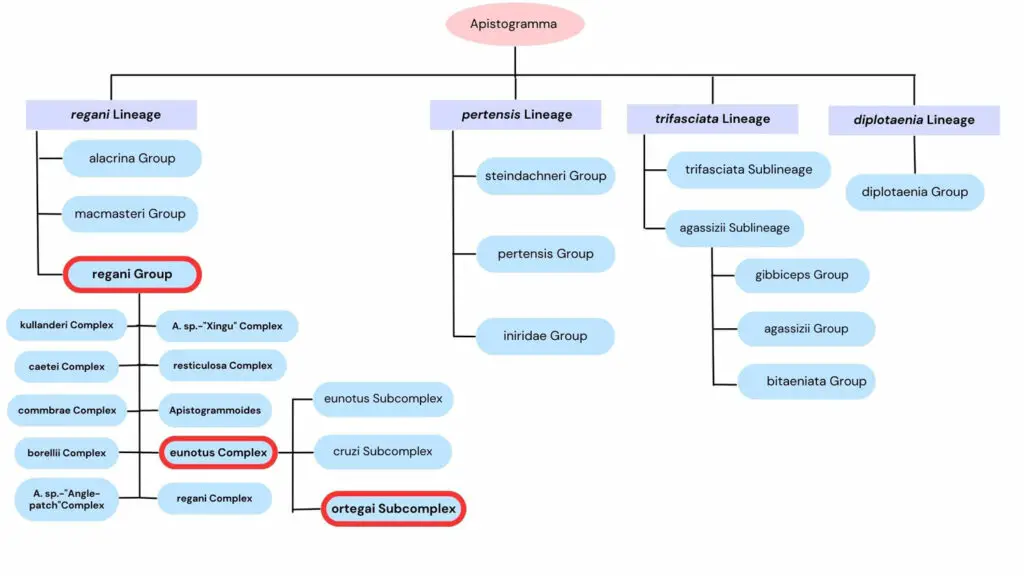
Apistogramma ortegai belongs to the eunotus complex of the regani Group. Species within the eunotus complex have a more rounded, laterally compressed body. They can also be recognized by their relatively wider lateral band and dark stripes on the abdomen.
In the regani Group, A. ortegai has specific characteristics to differentiate it from its relatives.
| A. commbrae | A. inconspicua | A. linkei | A. eunotus | A. cruzi | A. aguarico |
|---|---|---|---|---|---|
| Has vertical stripes on caudal fin | 1. Has vertical stripes on caudal fin 2. The lateral band running into tail spot | 1. Has vertical stripes on caudal fin 2. Has two vertical stripes on the posterior 3. Has horizontal stripes on the on abdomen | 1. Has 7-8 predorsal scales and 6-8 prepelvic scales 2. Has horizontal stripes on the on abdomen | Has 6-8 prepelvic scales | Has elongated lappets on dorsal fins |
Apistogramma sp. “Putumayo” Vs. Apistogramma ortegai

As mentioned, Apistogramma sp. “Putumayo” (sometimes called Apistogramma sp. Algodon II) is commonly mistaken for Apistogramma ortegai, not only because they originate from the same habitat but also due to their similar appearance.
The key difference between the two species is the caudal peduncle region. In Apistogramma sp. “Putumayo,” there is an oval-shaped black spot that is clearly separated from the last bar (7th) of the lateral band. In Apistogramma oretegai, this area is a large black patch that appears to extend from the 7th bar of the lateral band.
Apistogramma ortegai Size
Apistogramma ortegai are on the larger side for Apistos, with males growing to about 3.1 inches (8 cm) long and females tending to stay around 2.4 inches (6 cm) long.
Habitat and Tank Setup
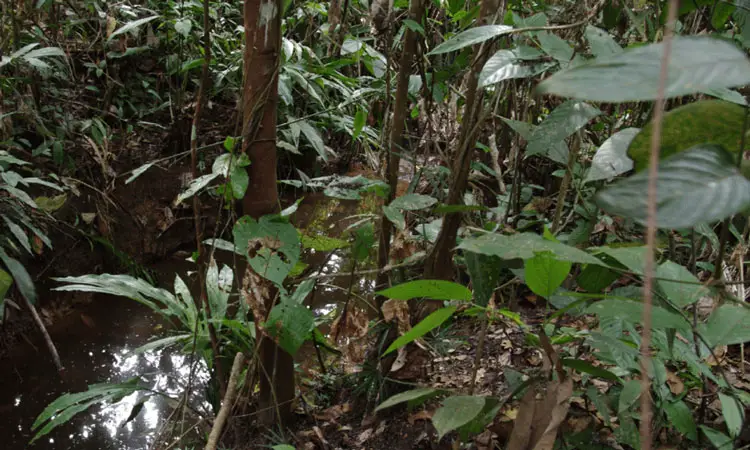
In its native habitat, Apistogramma ortegai is found in shallow, slow-moving streams surrounded by plants. The water is very clear and naturally soft and acidic due to the presence of fallen leaves, rotting wood, and other decayed plants on the banks. The pH range is usually between 5 and 6, and the water hardness is typically below 6 dGH.
Although undemanding when it comes to water conditions, this Apisto is not easygoing with its own kind. No matter what type of tank setup you are keeping this fish, plenty of hiding places must be provided.
Tank Size
The minimum aquarium size suggested for a breeding pair is 15 gallons (24″ x 12″ x 12″). Given the aggressive nature and large size of males, you should never have more than one male in tanks that are smaller than 20 gallons Long (30″ x 12″ x 12).
Water Conditions
Apistogramma ortegai are hardy fish and can live in a wide range of water conditions compared to those blackwater species. Water temperatures and pH levels are not critical, but it is wise to avoid extremes.
As an Amazonian dwarf cichlid, this fish is adaptable enough to handle very soft to moderately hard water, although soft water is preferred.
- Temperature: 72-82° F (22-28 °C)
- pH: 5.0 – 7.0 (Around 5 is ideal)
- Hardness: up to 10 degrees
- Conductivity: < 100 µS/cm (or TDS < 50)
The filter does not truly matter as long as the water is clean and the levels of dissolved oxygen (DO) are adequate. A sponge filter with an attached powerhead will do the job.
Plants, Substrate & Lighting
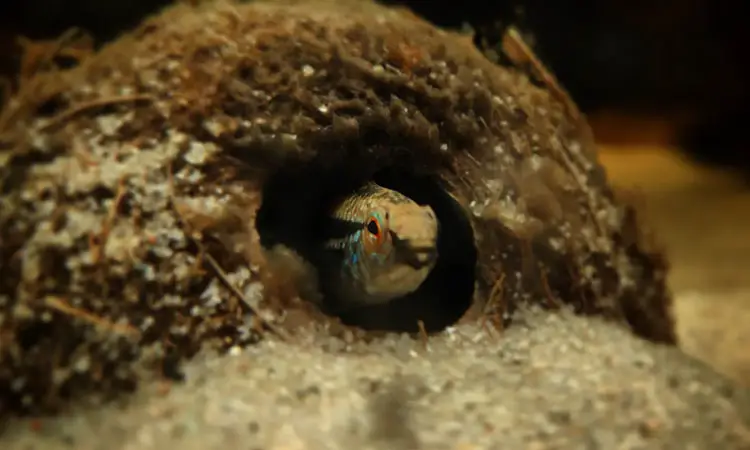
The substrate for an Apistogramma ortegai tank should be fine sand and darker in color. To create a South American biotope that imitates their natural environment, cover the ground with dead leaves, bogwood, and rocks.
Live plants, whether floating or rooted, are a great addition; they provide shelter and security for the fish and are a good way to keep the lighting dim and oxygenate the water.
Lighting should be subdued. Having a dark background on three sides of the aquarium and ensuring the light is not too bright will help to achieve the desired dark, shady habitat.
Consider adding additional hiding spots to build the visual territorial boundaries. Driftwoods, PVC pipe, treated flowerpots, and/or a DIY cave are some of the options available.
What Do A. ortegai Eat?
Since most specimens sold in the hobby are wild-caught, live food is the perfect meal for these carnivores. To ensure they get all the necessary nutrients, feed them a variety of live foods. Newly hatched brine shrimp, black mosquito larvae, or small worms are good sources.
Behavior & Tank Mates
Are Apistogramma ortegai aggressive? Yes, this species is considered to be more aggressive and territorial than other Apistos.
In small tanks, the dominant male will claim the entire bottom of the tank as its territory; subordinate males will not be tolerated; you may see them hiding among plants or swimming in the upper portion of the tank.
Mature males also get extremely aggressive toward females who are not ready to spawn; with such an aggressive nature, a trio of a male with two females is the typical setup.
They do well with other peaceful community fish that are similar-sized, so you may consider pairing them with some mid-to-top dwellers – like pencilfish, tetras, and dwarf rasboras.
As for shrimps, only large-sized Amano shrimp will be safe. Avoid adding any small invertebrates and snails. Apistos will readily consume them.
Remember, any Apistos need a bigger group to display their social behavior, so get at least three males with 4-6 females, and you won’t regret it.
Gender Differences

Males and females of Apistogramma ortegai show few obvious differences between the genders.
As with most Apistogramma species, males grow larger than females. The males tend to have a blueish head and develop a filamentous extension of the pelvic fin that can reach the end of the tail. Breeding females sport a bright yellow body with black blotches along the lateral line.
Breeding the Apistogramma ortegai
Like most species in the regani lineage, such as A. hongsloi and A. viejita, the A. ortegai is an “opportunistic” polygamy species, which means the male A. ortegai will mate with multiple females if given a chance.
This mating strategy allows the males to find a compatible female more quickly and increases their reproductive success.
The best way to establish a breeding pair is to purchase three males and at least six females and raise them to maturity together.
To optimize breeding success, set up a separate breeding tank with the same water parameters as the main tank, but the water temperature should be around 79ºF (26ºC).
Lighting must be kept very low; They are cave spawners, so add several flowerpots, PVC tubes, and coconut shells to hide the eggs.
The female will release up to 100 eggs. The eggs will be attached to the ceiling of the spawning sites, where they will hatch in three days; the fry will become free-swimming three days later.
Once the eggs have been laid, remove the male from the breeding tank, as the female will become extremely aggressive and may even kill the male.
Initially, feed the fry newly hatched brine shrimp until they are big enough.
More Apistogramma Species
If you have never kept dwarf Apistogramma cichlids, you may consider Apistogramma borellii, the perfect beginner Apisto. Apistogramma ortegai is more suitable for experienced enthusiasts.
For further inspiration and to learn about the wonderful world of Apistogramma dwarf cichlid, check out our section on Apistogramma species.
References:
- Wise, Mike. (Mar 16, 2023). “Apistogramma ortegai Britzke, Oliveira & Kullander, 2014”. Cichlid Room Companion.
- Mike Wise October, 2021. A Description of Apistogramma Species-Groups
- Apistogramma ortegai (Teleostei: Cichlidae), a new species of cichlid fish from the Ampyiacu River in the Peruvian Amazon basin http://dx.doi.org/10.11646/zootaxa.3869.4.5


